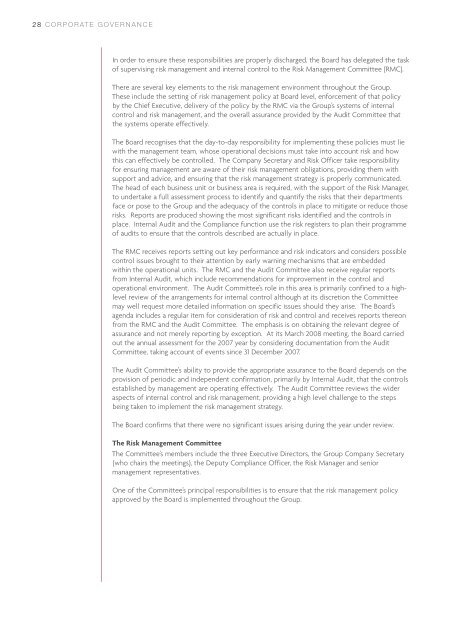annual report 2007 - the Admiral Group plc
annual report 2007 - the Admiral Group plc
annual report 2007 - the Admiral Group plc
Create successful ePaper yourself
Turn your PDF publications into a flip-book with our unique Google optimized e-Paper software.
28 CORPORATE GOVERNANCEIn order to ensure <strong>the</strong>se responsibilities are properly discharged, <strong>the</strong> Board has delegated <strong>the</strong> taskof supervising risk management and internal control to <strong>the</strong> Risk Management Committee (RMC).There are several key elements to <strong>the</strong> risk management environment throughout <strong>the</strong> <strong>Group</strong>.These include <strong>the</strong> setting of risk management policy at Board level, enforcement of that policyby <strong>the</strong> Chief Executive, delivery of <strong>the</strong> policy by <strong>the</strong> RMC via <strong>the</strong> <strong>Group</strong>’s systems of internalcontrol and risk management, and <strong>the</strong> overall assurance provided by <strong>the</strong> Audit Committee that<strong>the</strong> systems operate effectively.The Board recognises that <strong>the</strong> day-to-day responsibility for implementing <strong>the</strong>se policies must liewith <strong>the</strong> management team, whose operational decisions must take into account risk and howthis can effectively be controlled. The Company Secretary and Risk Officer take responsibilityfor ensuring management are aware of <strong>the</strong>ir risk management obligations, providing <strong>the</strong>m withsupport and advice, and ensuring that <strong>the</strong> risk management strategy is properly communicated.The head of each business unit or business area is required, with <strong>the</strong> support of <strong>the</strong> Risk Manager,to undertake a full assessment process to identify and quantify <strong>the</strong> risks that <strong>the</strong>ir departmentsface or pose to <strong>the</strong> <strong>Group</strong> and <strong>the</strong> adequacy of <strong>the</strong> controls in place to mitigate or reduce thoserisks. Reports are produced showing <strong>the</strong> most significant risks identified and <strong>the</strong> controls inplace. Internal Audit and <strong>the</strong> Compliance function use <strong>the</strong> risk registers to plan <strong>the</strong>ir programmeof audits to ensure that <strong>the</strong> controls described are actually in place.The RMC receives <strong>report</strong>s setting out key performance and risk indicators and considers possiblecontrol issues brought to <strong>the</strong>ir attention by early warning mechanisms that are embeddedwithin <strong>the</strong> operational units. The RMC and <strong>the</strong> Audit Committee also receive regular <strong>report</strong>sfrom Internal Audit, which include recommendations for improvement in <strong>the</strong> control andoperational environment. The Audit Committee’s role in this area is primarily confined to a highlevelreview of <strong>the</strong> arrangements for internal control although at its discretion <strong>the</strong> Committeemay well request more detailed information on specific issues should <strong>the</strong>y arise. The Board’sagenda includes a regular item for consideration of risk and control and receives <strong>report</strong>s <strong>the</strong>reonfrom <strong>the</strong> RMC and <strong>the</strong> Audit Committee. The emphasis is on obtaining <strong>the</strong> relevant degree ofassurance and not merely <strong>report</strong>ing by exception. At its March 2008 meeting, <strong>the</strong> Board carriedout <strong>the</strong> <strong>annual</strong> assessment for <strong>the</strong> <strong>2007</strong> year by considering documentation from <strong>the</strong> AuditCommittee, taking account of events since 31 December <strong>2007</strong>.The Audit Committee’s ability to provide <strong>the</strong> appropriate assurance to <strong>the</strong> Board depends on <strong>the</strong>provision of periodic and independent confirmation, primarily by Internal Audit, that <strong>the</strong> controlsestablished by management are operating effectively. The Audit Committee reviews <strong>the</strong> wideraspects of internal control and risk management, providing a high level challenge to <strong>the</strong> stepsbeing taken to implement <strong>the</strong> risk management strategy.The Board confirms that <strong>the</strong>re were no significant issues arising during <strong>the</strong> year under review.The Risk Management CommitteeThe Committee’s members include <strong>the</strong> three Executive Directors, <strong>the</strong> <strong>Group</strong> Company Secretary(who chairs <strong>the</strong> meetings), <strong>the</strong> Deputy Compliance Officer, <strong>the</strong> Risk Manager and seniormanagement representatives.One of <strong>the</strong> Committee’s principal responsibilities is to ensure that <strong>the</strong> risk management policyapproved by <strong>the</strong> Board is implemented throughout <strong>the</strong> <strong>Group</strong>.
















